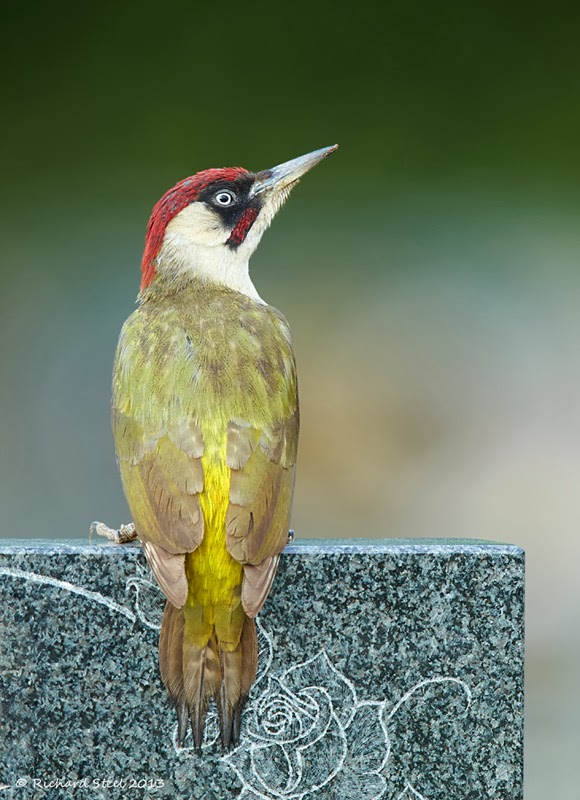Cemeteries can offer some good opportunities for photography as they often provide a large oasis of green space within an urban setting in a similar way to parkland. They are relatively quiet and undisturbed places for the majority of the time and a steady trickle of visitors allows the wildlife (with the exception of green woodpeckers!) to become accustomed to the presence of people. Before you all rush out to your local graveyard with your camera, please consider the purpose and emotional sensitivity of the place. I have two basic rules which are visit at first and last light, which is best for the wildlife and light quality and when there are very few if any people present, and head to the quieter areas. I would urge you never to photograph around people visiting the graves of their lost relatives as this disrespectful and they should be given a wide berth.
Anyway on to some green woodpecker photographs which after all is the purpose of the post. After several short sessions with the male bird I had got a good understanding of his behavioural routine during the evening which was allowing me to firstly find him and encouragingly to get photographs on each session. Some sessions were more successful than others but I knew by repeatedly visits I could built up a collection of images.
Green woodpeckers spend a large amount of time digging to find their main prey ants. A couple in action in the following photographs.
You will notice on the second of the photographs above the thick membrane that covers the eye to protect it from flying soil and also from ants. When they are busy feeding its is common to see several ants running around the bird's body, no doubt doing their best to try and fend off the attackers from the nest. One particular evening the male woodpecker was slowly excavating a whole in a patch of soil when the recently fledged young bird came hopping over. It watched the adult digging for a while before having a go itself. As with many things often the best way to learn is to watch an expert in action.
A couple more photographs of the solitary young bird which was usually fairly easy to find as it was incredibly noisy and repeatedly calling to keep in contact with the adult. You can see in the first photograph a small patch of red forming under the eye so it looks like this will be another male.
I will finish off with one of my favourite images from the sessions which is a dorsal view of the adult perched on a gravestone showing the lovely bright yellow flash of its rump. They really are such a beautiful looking woodpecker and it was a real pleasure to share some time, despite the inevitable frustrations, with such a camera shy bird.
By the end of July the birds became less predictable and patterns started to change until they both disappeared and the window of opportunity had closed. The male presumably went in to moult and the young bird will have dispersed to find itself a territory. Hopefully they will be back in the 'Green Oasis' next year to provide some more memorable summer evenings with the camera.




.jpg)





















6 comments:
I specially like the third image. Is it usual for a juvenile and male to be together without a female as seems to be the case here?
A superb set of images Rich. I used to visit a graveyard regularly living at my previous residence but never found much wildlife in it.
Your experience, time and patience has paid off handsomely.
Maggie Campbell
A beautiful set of images Rich. Your experience and patience have paid off handsomely.
WOW....these are magnificent!!
Beautiful, Rich. Patience and perseverance certainly paid off.
Thanks for the comments which are appreciated as always. I have only ever seen the juveniles with the male and strangely never seen the female at this site. I assume that she has a different foraging area. However, it does seem to be the responsibility of the male to stay with the fledged young for a couple of weeks before they disperse.
Cheers
Rich
Post a Comment